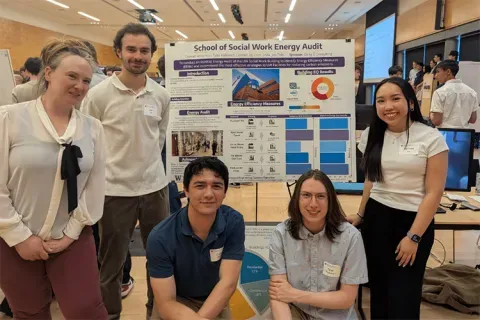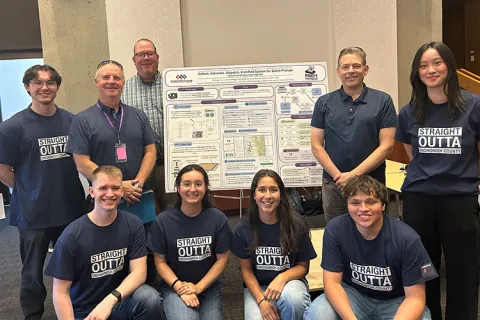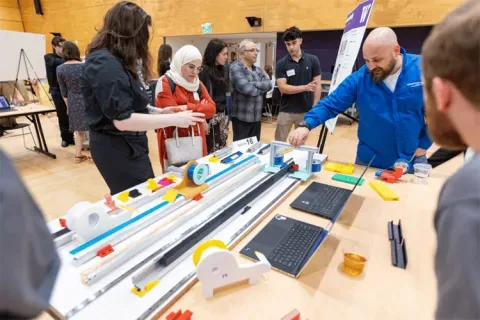Industry-Sponsored Student Capstone Projects
2022/2023
In the 2022/23 academic year the industry capstone program was supported by 56 sponsors and 99 real-world projects. Nearly five hundred and fifty students from across the College of Engineering participated. Scroll down to learn more about each project.National Oceanic and Atmospheric Administration (NOAA)
Intertidal Sensor Array for Monitoring Ocean Change Stressors in Oyster Farms
This student team worked with a team of researchers at the NOAA Northwest Fisheries Science Center (NWFSC), the University of Washington School of Aquatic and Fisheries Science (SAFS), and Baywater Shellfish to develop a robust intertidal sensor array that can be deployed by shellfish growers to measure water quality parameters related to ocean change. The student team attempted to expand on capstone work from 2021/22 and work to produce data that can be used by growers to identify appropriate management strategies. The key parameters were temperature, pH, oxygen, salinity, and chlorophyll. To accomplish this, the student team worked to combine commercially available sensors with newly designed components that integrate data management, power supply, and wireless communication in a physically robust package that is intended to function in a harsh environment. The student team attempted to produce a functioning sensor array that they will field test in local shellfish farms. If successful, the array would provide reliable data at the target precision. The student team was also expected to write documentation of sensor design and operation, including deployment and maintenance S.O.P.s and sensor analysis software user manual.
National Security Innovation Network (NSIN)
Electronically Steerable Ultra-Wideband Antenna
The National Security Innovation Network (NSIN) is a network in the U.S. Department of Defense (DOD), aimed at connecting DOD entities with academic and venture partners to innovate new solutions for DOD-member challenges. This student team worked to create an ultra-wideband electronically steerable flat panel antenna capable of tracking and communicating with satellites out to Geosynchronous Orbits. Desired Frequency Range is ~400 MHz to ~11GHz Goals and objectives this student team worked to meet included: • Support maximum flexibility and use of software defined radios • Antenna that requires no assembly or mechanical steering to track objects in flight including satellites on orbit • Low cost solutions are preferable • Antenna must fit on top of a standard 20 ft shipping container
National Security Innovation Network (NSIN)
Navy Requirements Markup Language
The National Security Innovation Network (NSIN) is a network in the U.S. Department of Defense (DOD), aimed at connecting DOD entities with academic and venture partners to innovate new solutions for DOD-member challenges. Navy specifications and requirements are usually presented in a narrative long form (e.g., paragraph), see example below. Common requirements types are: Build Specifications; MILSPECs; CONOPS, and Industry Standards. Example Narrative Requirement: “Each educator shall be selected based on an actuating fluid of seawater at 20°C and available firemain actuating pressure, a suction lift equal to X.X m (YY feet) of water, the capability to discharge its rated capacity against a head equivalent to the height of its overboard discharge plus the resultant dynamic losses, and a service fluid containing solids up to ZZ mm in diameter. The nozzle tip and the throat of the discharge shall be such that the flow of fluid at the capacities listed in Table I will not produce erosion of the parts under service operating conditions.” The Challenge: These narrative requirements are hard to parse visually, and nearly impossible parse using machines in any effective timeframe. Machine readable requirements are a major enabler for digital engineering transformation efforts. This student team worked to achieve the following solutions: 1. Develop standardized navy requirement markup tags extending the schema.org standard tags. 2. Convert various requirement document types utilizing extended markup language. 3. Develop AIML natural language processing to scale up conversion of requirement documents to machine readable documents
National Security Innovation Network (NSIN)
Wireless Embedded Sensor Monitoring
The National Security Innovation Network (NSIN) is a network in the U.S. Department of Defense (DOD), aimed at connecting DOD entities with academic and venture partners to innovate new solutions for DOD-member challenges. There are many off the shelf type sensors such as accelerometers, pressure transducers, flow, current, voltage and temperature sensors that operate in certain ranges and frequencies rates to output data. These sensors need to be installed at specific locations on the equipment or unit under test that requires many of them to be installed without obstructing the equipment operation. Wired sensors are a bit challenging to manage because of all the wires necessary to feed into a data acquisition system. Wireless sensors eliminate the challenges with wires but wireless must be secure enough to meet stringent cyber security requirements and be resilient enough to prevent attack or break down from usage. The form factor of the sensor would be embedded in equipment such that it is secure and rugged and can withstand the rigors of the environmental and operational conditions and not impede or interfere with equipment or process of operation. The wireless radio should be able to reach up to 200 feet from the equipment to the point of reception of the data and be of low power so that the battery can operate up to 10 years. The sensor(s) would be triggered when there is an event that occurs to activate the sensing quickly in less than 1ms. The sensor should be reasonably priced compared to similar sensors and readily available in the market place. This student team worked to build a small sensor that can fit into equipment form factor, be non-intrusive, and send out accelerometer/vibration data out at least at a 10KHz rate. This student team also worked to identify an interface that allows a wireless radio to be paired to a sensor and test the data rates that the sensor and radio can reliably perform and identify if the bandwidth of the radio is sufficient to handle the data needs of the application to collect all the data.
Novo Nordisk
Application for Early Alzheimer's Disease Diagnosis
Detecting the onset of early-stage Alzheimer’s Disease, along with monitoring the progression of the disease, is well-known to be difficult and, often-times, unreliable. Simply put, there has yet to be a clinically validated tool or methodology for determining the biomarkers that indicate the presence and progression of Alzheimer’s disease. This student team worked to develop a digital tool that can integrate inputs from well-established, in-home, and wearable devices as data which, through an AI and ML programmatic approach, aims to synthesize that data, providing a reading which can indicate both the presence of Alzheimer’s Disease and the degree of change of that disease over time. Two key factors which are baseline and that the student team worked to incorporate into the tool were inputs which capture the patient's gate (wearable) and sleep patterns (wearable and/or smartphone). The student team sought to include other data inputs incrementally as project timing/cost/complexity allows. These included some or all of the following: speech patterns, eye tracking, reading tracking, device patterns (typing and gestures), home movement patterns. The essential concept here is that more inputs equal more data to integrate and provide a more focused and complete picture of the patient's condition. Outcomes this student team worked toward include: • Working prototype, end-user platform/tool • Solution accessible from tablet or smartphone • Name and branding for tool • Mapping and progressive design outputs (e.g. journey map, app map, flowchart, thumbnails, design comps, etc.) • Software which displays the appropriately modified information and diagnostic recommendations (personalized to their capability/level of ability) in a usable (accessible - UX standards) visual format (easy to use dashboard and navigation). • Demonstrated successful real world use/testing - patients can easily access the application with the follow-on understanding of the appropriate information/course of action through the interface
Novo Nordisk
Data Insights Application for Financial Implications of Chronic Disease
Financial implications often impact those suffering from a chronic disease. Improving the patient experience and outcomes in the chronic disease space is an ongoing critical need, and this student team worked to focus on the financial impact on those suffering with sickle cell disease. Patients with sickle cell disease experience significant lifetime costs associated with obtaining and receiving adequate medical care. This student team worked towards the development of a data model that captures and analyzes patient-level cost information to drive informed decision making. Anticipated outcomes this student team worked toward include: • Working prototype, end-user platform for our sickle cell cost tool • Solution is accessible from desktop, tablet, and smartphone • Name and branding for tool • Reporting/visualization output designs
Novo Nordisk
Data Insights Application for Obesity
Comorbidity risk is an ever-present concern for patients with obesity. This student team worked to create a data insight application that provides a quantitative view into the comorbidity risk present in a patient with obesity through the modification of weight, social determinants of health (SDoH), and associated risk factors. The data model built aimed to support the application utilizes clinical, commercial, and SDoH data to understand the correlations between obesity, related comorbidities, and SDoH. The vision for the application was to provide internal Novo Nordisk (NNI) stakeholders quantitative insights into risks faced by patients to better educate clinicians about the risks and costs associated with obesity. This student team worked towards defining, designing, and developing the application for the obesity tool. Anticipated outcomes this student team worked toward include: • Working prototype, end-user platform for our obesity tool • Solution is accessible from desktop, tablet, and smartphone • Name and branding for tool • Reporting/visualization output designs
Novo Nordisk
Digital Companion for Chronic Disease Patient
It is estimated that 1/3 of people diagnosed with a serious, life-changing chronic illness or disease will experience symptoms of depression such as loneliness, sadness, isolation, and despair. As chronic conditions such as Type II Diabetes and Alzheimer’s Disease increase, the condition of depression rises commensurately. Compounding the circumstance, many people who suffer from chronic illness and depression remain isolated or homebound. Finding a solution in-home to alleviate depression can help these people achieve more positive health outcomes. This student team worked to develop a digital companion device (digital robot/pet, standstill device, Tamagotchi-like device, etc.) which would provide information and direction for helping this patient manage their condition (dietary, physical activity, medication management, emotional support, etc.) but more importantly, provide the patient with personified feedback that is customized to their unique needs as well as employing ML/AI to both learn (train) and remember. These were meant to be in the form of command -based and proactive interaction. The student team worked to build a robot that would ideally employ multiple output modalities such as voice, on-screen text and visuals, LED’s, movements, and sound effects, to create a more extensive and dynamic experience for the patient. The robot could also employ a personality (similar to chatbots) as well, creating a personal/customized connection with the patient. Anticipated outcomes this student team worked towards included: • Working prototype, end-user platform • Solution is accessible from smartphone or wearable • Name (personality) of tool • Drawings, schematics, plans for tool elements beyond physical prototype
Novo Nordisk
Medication Management for Alzheimer's Disease Patient
In most cases of Alzheimer’s Disease, the average age of diagnosis is between the ages of 55 to 64 years. Given this average age of diagnosis, and the length of time which the disease progresses, many of these Alzheimer’s patients have also been diagnosed with other co-morbid conditions, such as type 2 diabetes, cardiovascular disease, gastrointestinal disease, and depression. Managing the medications for some, or in some cases all of these conditions, is notoriously complex and difficult for both the patient and the caregiver. Medication contraindications often occur, and the patient will need to deny one medication in order to take one that is deemed more critical. Further complications often arise, given the cognitive impairment of the patient, which places more stress on the caregiver to negotiate the polypharmacy demand and avoid adverse events for the patient. This student team worked to develop a tool/device and/or process which can alleviate the complexity of this circumstance for the Alzheimer’s patient in particular, but could also be utilized for other complex medical conditions. This tool attempted to utilize the unique medical circumstance of the user (patient) and be able to communicate a plan for the patient to manage their medications through distinct direction and/or dispensing, or both. This may be a stand-alone device (dispense medications) or a smartphone application which guides/manages the patient, and may be designed to accommodate the degree of Alzheimer's (mild, moderate, severe impairment). Anticipated outcomes this student team worked toward include: • Working prototype, potential hardware/device, end-user platform/application • Solution is accessible from smartphone, wearable or as standalone device • Drawings, schematics, plans for tool elements beyond physical prototype

PACCAR
Automation of Dash Tester Connections
This student team worked to create an automated solution capable of accurately and repeatedly connecting and disconnecting a plate containing multiple cable connectors to the connectors on the rear of an assembled dash to be tested at the production plants. This automation could potentially be used in a plant, along with all of the information (plans, source code, diagrams, et cetera) required for the Manufacturing Support Team to build more and was intended to free up test operators to be able to use their time more efficiently and reduce the amount of time required to test each dash. The intention was to save time and money for the plant and the company as a whole. This was the final part of a larger effort to automate the testing process and will be extremely valuable to the Manufacturing Support Team and the manufacturing plants themselves.

PACCAR
Battery Electric Vehicle (BEV) Range Estimation Tool
With multiple new battery electric powertrains under development, there is a need to optimize component sizing and select the right configuration for different real-world vehicle applications. The goal of this project was to include the different components of a BEV powertrain and a generic optimization algorithm to determine required component sizing such as batteries, e-motors, etc. In prior years, an algorithm was determined to help estimate energy consumption based off a drive cycle. This year, the student team worked to design a user interface tool that would help determine the best component sizing for an application and is capable of optimizing the vehicle configuration based on user inputs and variables (i.e., battery sizing for a given drive cycle, vehicle weight and mass, and motor size). This tool was intended to evaluate and optimize powertrain configuration based on a different drive cycles and performance requirements. The student team was expected to prioritize GUI over adding complexity to the model. The model could have been updated from the previous project, or be used as-is, depending on time available and the skill set/interests of the group. Due to the large number of variables, optimization algorithms / machine learning were required to reduce computational costs.

PACCAR
Driver Classification
This student team worked to add a new classification layer and behavioral prediction to autonomous driving. The main objective was to classify and predict reckless drivers by identifying specific trends and indicators while continuously monitoring the vehicle's surrounding area. Due to the complexity of the objective, the project scope was divided into multiple phases, with Phase I taking place in the 2022/23 Industry Capstone Program. PHASE I: This phase was meant as a proof of concept. The algorithms the student team worked to create in this phase are intended to be tested on a small-scale database. A small-scale database contains a limited number of training data and testing objects, which was to be defined in detail during the early stages of the project. The Phase I student team was expected to: - identify the specific indicators for reckless driving - generate a prediction algorithm based on the identified indicators - detect and classify a specific vehicle - track and monitor the behavior of the classified vehicle. Phase I and 2 student teams worked to classify and identify driving characteristics that represent reckless behavior, including creating requirements that would identify reckless behavior. For these phases and subsequent phases, a stretch goal was for the student team(s) to identify additional driving characteristics/targeted behavioral patterns, such as: “dead pedal”, speeder, weaver, angry/aggressive, brake checker, vehicle speed limited, strict speed limit follower, normal, erratic, inattentive, defensive, etc., and define written requirements for these additional driving characteristics/targeted behavioral patterns.

PATH
Harvest and Prioritize Excess Solar Power
PATH, with partners, has previously worked to specify and field test "energy harvesting" equipment for solar powered vaccine refrigerator installations that have been approved by the World Health Organizations Performance, Quality, and Safety team. The critical refrigeration load always receives the power it needs while any additional power can be accessed by additional user loads. PATH has a long history of product development of technologies that are fit for difficult situations and addressing unmet user needs and opportunities. Oxfam currently provides technical support to the humanitarian water, sanitation, and hygiene (WASH) sector for quality implementation of solar powered water pumping solutions. The power system (solar photovoltaic array) is sized to account for cloudy days and periods of low insolation which means there is excess power available most of the time. Oxfam is often asked if there is a way to tap this unused power at water pump installations, but no commercial technology exists for this application. PATH has been approached by Oxfam to work toward a parallel energy harvesting product for these installations. This student team worked to take initial steps toward defining and designing a technology to harvest this extra power for other uses while ensuring that the primary water pumping system still receives all the power it needs. More broadly, this development ideally would lead towards design of a universal device that could be used in any similar solar powered systems that generate unused power. Desired outcomes this student team worked towards included: 1. Initial landscape of similar technologies, preliminary confirmation that there aren't already products out there that just need modification (this has been done, but a more comprehensive landscape and research will be useful at the outset). 2. A basic target product profile (TPP) document to solidify design requirements and targets 3. Conceptual design following the TPP with a design review 4. Conceptual design of the physical user interface for power/load prioritization (possibly with basic, opportunistic user feedback) 5. Initial prototyping of an example device 6. Documentation of design in form of white paper or defensive publication
Photon Marine
Marine Range Estimation Calculator for EV Systems
Photon Marine is developing electric outboard propulsion systems and intelligent energy management software for commercial boat fleets. These fleets operate in tourism, transportation, and mariculture sectors, traversing the most fragile marine ecosystems in the world. One of the primary considerations for transitioning to electric propulsion is whether or not the batteries will provide sufficient range for a particular use case. Because each case is unique, blending a combination of vessel type, distance traversed, operating speed, charging infrastructure available, and ambient weather conditions, the answer to "how far can I go?" depends on a number of factors. This student team worked to to build a real-time range estimation tool, as part of Photon Marine's onboard software platform, in order to understand how useful ICE motor data can be in modeling for electric systems. The system this student team worked to build could incorporate environmental data from wind and tide sensors, understand where the vessel departed from and needed to return to, and keep a long of boat performance over time. This would allow the system to learn from previous trips to create accurate range estimation. This student team also worked to develop an early functioning prototype for range calculation. As a stretch goal, this student team worked to produce a design or a prototype for a public-facing website tool so that prospective customers can pre-qualify whether electric propulsion suits them. Such a tool might also gather a few more data points such as cost of electricity and fuel costs in order to determine payback period for an electric propulsion system.
Puget Sound Energy (PSE)
Transmission System Hosting Capacity Map
Puget Sound Energy (PSE) faces an increasing need to acquire generation resources to meet customer demand, as well as the renewable resource goals outlined in the Clean Energy Transformation Act. Developers seeking to interconnect generation to the system, as well as load (including charging of Battery Energy Storage Systems), face increased congestion due to factors such as electrification, EV adoption and an increased penetration of DER. This system congestion results in increased interconnection costs for the developer, who bear the costs of the system upgrades needed to accommodate these resources. This student team worked to develop a transmission system hosting capacity map to indicate to developers which areas of the system may be constrained and where there may be available capacity to accommodate new resources. This map may also be used to identify areas where PSE can target proactive projects to facilitate the integration of renewable resources. The hosting capacity needed to be determined for both generation and load in consideration of system performance requirements under NERC credible contingencies. The desired project outcome for this student team was a methodology and (potentially automated) process for calculating hosting capacity on all PSE transmission lines. This student team worked to complete calculation of hosting for both generation and load under a variety of NERC credible contingencies (including all lines in service, N-1 and N-1-1) for both summer and winter seasons for the upcoming year. As time allowed, this student team was able to work to study and represent additional scenarios on the map (such as studying an 10-year scenario to identify whether future system projects will benefit/impact hosting capacity) . This student team worked to deliver a GIS map that color codes transmission facilities based on the amount of capacity available for interconnecting new resources.
Related News

Mon, 10/13/2025 | UW Mechanical Engineering
Capstone collaboration leads to award
An ME capstone team received first place for its energy audit of the UW School of Social Work building.

Thu, 07/17/2025
UW engineering students develop smart ballot solution
UW engineering students develop smart technology solution to improve ballot collection for Snohomish County.

Mon, 07/07/2025 | UW Mechanical Engineering
Capstone creations
Students displayed innovative capstone design projects at the 2025 expo.

Fri, 09/20/2024 | UW Civil & Environmental Engineering
Smarter irrigation for a greener UW
A new project combines satellite data with ground sensors to conserve water and create a more sustainable campus environment.